Biogeochemistry Lab
Research
Nitrogen cycle
Nitrogen is frequently the limiting nutrient for plant productivity in terrestrial and marine ecosystems. However, many estuarine and coastal environments are severely perturbed by anthropogenetic nitrogen input, leading to eutrophication, hypoxia, and many other deleterious consequences. The bioavailable pool of nitrogen is not only affected by the nitrogen input but also regulated by biological nitrogen transformation processes within these systems (see figure below).
To better understand nitrogen bioavailability in the environment, there is a need for reliable estimates of the distribution of nitrogen cycling processes and microbes that conduct these processes. Our lab measures nitrogen cycling processes across diverse natural environments and under experimentally manipulated environmental conditions to simulate climate change. For example, we measured substrate kinetics of nitrification, denitrification and anammox in estuarine waters and developed a mechanistic model to estimate in situ nitrogen cycling rates, which allowed us to explain the concurrently observed distribution of inorganic nitrogen nutrient (Tang et al., 2024). Ongoing work includes assessing the response of nitrogen cycling processes to multiple stressors under climate change (e.g., nitrification and denitrification in response to deoxygenation Tang et al., 2025a and Tang et al., 2025b). Our observed substrate kinetics parameters, oxygen sensitivity and many aspects of the nitrogen cycling could guide the improvement of biogeochemical models.
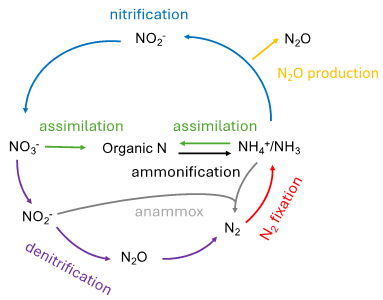
Figure caption: Major transformations in the nitrogen cycle.
Nitrous oxide cycling in the aquatic environment
Nitrous oxide (N2O), a powerful greenhouse gas (has ~300 times the global warming potential of CO2) and the dominant ozone-destructing substance, is produced during the nitrogen transformation in the aquatic systems. The aquatic systems including ocean, estuaries and inland waters are large but poorly constrained sources of N2O to the atmosphere. This uncertainty is partly due to the sparse observations and lack of mechanistic understanding of N2O cycling processes.
By applying both nitrogen stable isotope tracers and molecular techniques to directly measure nitrogen transformation rates and the microbes performing these processes, I provided the first comprehensive view of N2O cycling in the seasonally anoxic Chesapeake Bay while I was a postdoc in the lab of Professor Bess Ward at Princeton University (Tang et al., 2022a and b). Nitrification and denitrification were identified as the dominant production pathway in oxygenated and anoxic waters respectively. A large potential of N2O consumption in both oxygenated and anoxic estuarine waters were characterized for the first time. The ongoing work is assessing the response of N2O cycling to environmental changes like warming, deoxygenation, acidification and nitrogen loading changes using both field observations and model simulations (e.g., Tang et al., 2024). In addition to natural aquatic environments, we have also assessed the impact of wastewater treatment plant on N2O emissions, finding a generally substantial increase in N2O emissions downstream of wastewater treatment plants (Tang et al., 2024).
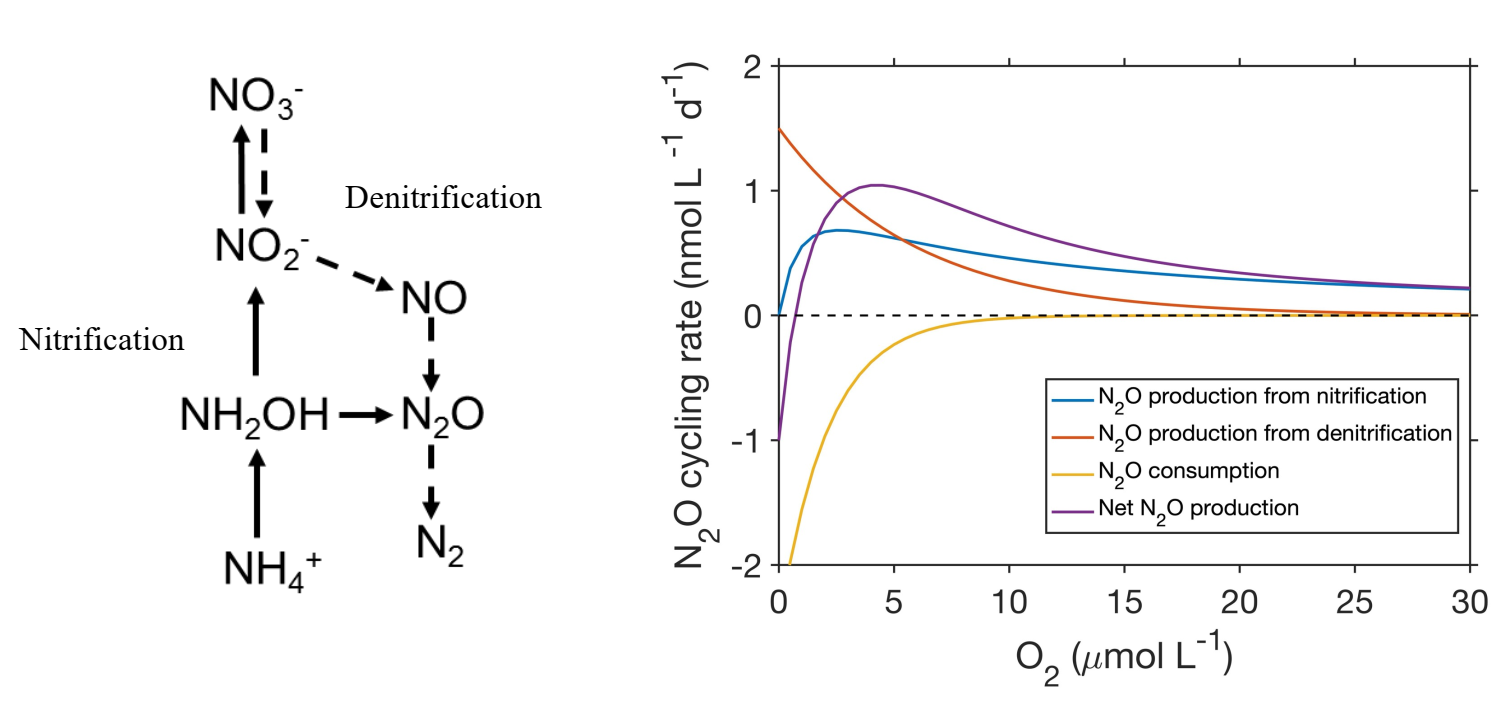
Figure caption: A simplified view of N2O cycling processes (left) and a schematic diagram showing the response of N2O cycling rates to oxygen concentration changes (right).
Marine carbon cycle in a changing climate
Nearly half of the net primary production on Earth occurs in the oceans, which plays an important role in supporting fishery and regulating the atmospheric CO2 level. Marine primary production is affected by many environmental drivers including light, temperature, and nutrients. For example, iron is hypothesized to limit phytoplankton growth in the high-nutrient, low-chlorophyll (HNLC) regions including the North Pacific, Equatorial Pacific, and Southern Ocean.
Using satellite observations, biogeochemical Argo floats and atmospheric modeling, we found iron in aerosols emitted from 2019-2020 Australian wildfires (from both biomass burning and dust) fueled widespread phytoplankton growth in the Southern Ocean, potentially leading to a substantial increase in carbon uptake by the ocean (Tang et al., 2021). This study raises public awareness of the far-reaching impact of wildfires and the complex role of wildfires in Earth’s climate system. Ongoing research in our group evaluates the controlling factors of marine productivity and carbon uptake in the global oceans.
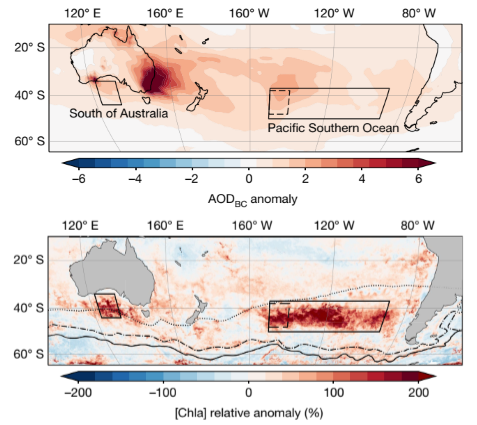
Figure caption: Large increase in chlorophyll a concentration in response to wildfire aerosol deposition.
Compilation and meta-analysis of nitrogen cycling processes in the global ocean
The number of observations of different biogeochemical processes are accumulating globally. Compilation and meta-analysis of large datasets using statistical approaches and machine learning help us to better understand the distribution and controlling factors of biogeochemical processes and guide future observation efforts.
A database of nitrification and nitrifiers in the global ocean has recently been constructed (Tang et al., 2023). We are developing a new model parameterization for nitrification based on the newly compiled database. The new parameterization will be incorporated in Earth System Models to assess changes in nitrification rates under climate change and its subsequent impacts on marine productivity.
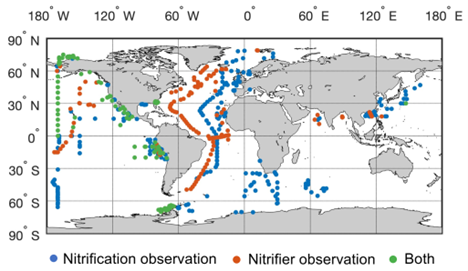
Figure caption: Compilation of nitrification and nitrifier observations in the global ocean
Machine learning algorithms have been applied to estimate N2 fixation and diazotrophs in the global ocean using our compiled database of N2 fixation rate and diazotrophs abundance (Tang et al., 2019 a and b). For example, machine learning-estimated global marine N2 fixation ranges from 68 to 90 Tg N/year. Comparison to other model estimates shows substantial discrepancies in the global magnitude and spatial distribution of marine N2 fixation, especially in the tropics and in high latitudes.
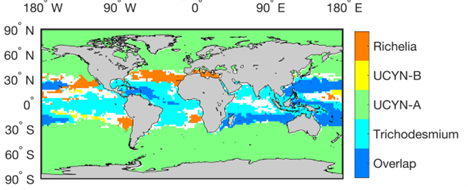
Figure caption: Estimated niches of different diazotrophs in the global ocean.
Method development for high resolution observations of biogeochemical processes
Technological advances help to better observe and understand the Earth system. As a graduate student under the guidance of Professor Nicolas Cassar at Duke University, I developed and applied an unprecedented high-resolution underway method to measure N2 fixation (a major external source of nitrogen to the ocean) (Cassar, Tang et al., 2018). Extremely high N2 fixation rates and associated substantial contributions to primary production were discovered in the coastal waters of the eastern United States (Tang et al., 2019; 2020). These unexpected observations challenged the traditional view of the distribution of marine N2 fixation in which N2 fixation dominated in oligotrophic open waters. Development of other high-resolution observation methods and analytical techniques continues in our lab at USF.
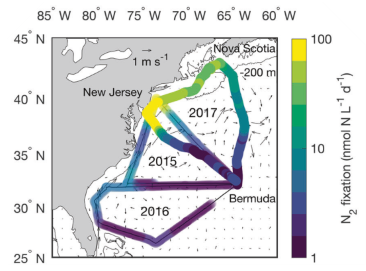
Figure caption: Underway continuous measurements of N2 fixation rate in the North Atlantic.